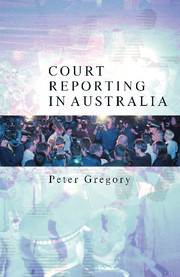Book contents
- Frontmatter
- Contents
- Figures and Tables
- Acknowledgments
- Introduction
- Chapter 1 The Court System: An Overview
- Chapter 2 Gaining Information
- Chapter 3 Contempt
- Chapter 4 Defamation
- Chapter 5 Writing the (Newspaper) Story
- Chapter 6 Subediting and Photography
- Chapter 7 Television and Radio
- Chapter 8 Human Relations and Ethics
- Chapter 9 An Atypical Friday at Court
- Chapter 10 Suppression Orders
- Chapter 11 Future Directions and Issues
- Bibliography
- Index
Chapter 5 - Writing the (Newspaper) Story
Published online by Cambridge University Press: 22 September 2009
- Frontmatter
- Contents
- Figures and Tables
- Acknowledgments
- Introduction
- Chapter 1 The Court System: An Overview
- Chapter 2 Gaining Information
- Chapter 3 Contempt
- Chapter 4 Defamation
- Chapter 5 Writing the (Newspaper) Story
- Chapter 6 Subediting and Photography
- Chapter 7 Television and Radio
- Chapter 8 Human Relations and Ethics
- Chapter 9 An Atypical Friday at Court
- Chapter 10 Suppression Orders
- Chapter 11 Future Directions and Issues
- Bibliography
- Index
Summary
Journalists are the link between the courts and the public. Take the word of a Supreme Court judge who dismissed an application by media interests for documents in a criminal case. The judge upheld a general right for journalists to have information from courts as long as it allowed fair and accurate reporting to take place. When reporters translate legalese into plain language for non-lawyers, fairness and accuracy should be at the front of their minds. As discussed in Chapter 3, journalists can publish normally defamatory or outrageous statements made in court provided the reports are fair and accurate. Added to the enjoyment is the pressure of deadlines. Court stories must be balanced, they must reflect the day's proceedings, they must contain basic details to establish their veracity and they must be written on time.
Basic details
Start with the attitude that you are the readers' eyes and ears. When you cover a case, you want them to know what the case is about. Telling them simple facts helps you to do that. It also helps later if you are asked to justify the accuracy of your report. And be accurate. The last thing you want to hear from a judge or lawyer criticising your story is: ‘You couldn't even get my name right.’
- Type
- Chapter
- Information
- Court Reporting in Australia , pp. 69 - 90Publisher: Cambridge University PressPrint publication year: 2005



